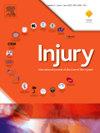Management of post-injury anticoagulation in the traumatic brain injury patient: A scoping review
IF 2.2
3区 医学
Q3 CRITICAL CARE MEDICINE
Injury-International Journal of the Care of the Injured
Pub Date : 2025-02-01
DOI:10.1016/j.injury.2025.112159
引用次数: 0
Abstract
Traumatic brain injury (TBI) remains a leading cause of morbidity and mortality among trauma patients. The care of these patients continues to be a complex endeavor with prevention of associated complications, often requiring as much attention as that of the treatment of the primary injury. Paramount among these are venous thromboembolic events (VTE) due to their high incidence, additive effect on the risk of morbidity and mortality, and the careful balance that must be utilized in their diagnosis and treatment to prevent progression of the brain injury itself.
In this review, we have synthesized the most recent major studies detailing the ideal choice of chemoprophylactic agent, the timing of initiation, and continued monitoring and management strategies through the hospital course and beyond. Additional discussion is provided for subpopulations in which management can vary significantly, including the elderly, critically ill, and obese. Ultimately, current literature supports the use and safety of low molecular weight heparin over unfractionated heparin, especially when dosed using newer assays including anti-Xa levels. The timing of prophylaxis remains important, as the risk of VTE increases with each day that prophylaxis is held. Consensus findings favor initiation within 24–72 h, in the absence of documented progression, life threatening bleeding, or need for major surgical intervention. Despite available data, there continues to be significant variability in practice patterns which we hope to address with this review.
外伤性脑损伤患者伤后抗凝治疗的管理:范围综述。
创伤性脑损伤(TBI)仍然是创伤患者发病和死亡的主要原因。对这些患者的护理仍然是一项复杂的工作,预防相关并发症往往与治疗原发性损伤同样重要。其中最重要的是静脉血栓栓塞事件(VTE),因为其发病率高,对发病和死亡风险有叠加效应,而且在诊断和治疗时必须小心平衡,以防止脑损伤本身恶化。在这篇综述中,我们综合了最新的主要研究,详细介绍了化学预防药物的理想选择、开始治疗的时机以及住院期间及以后的持续监测和管理策略。此外,还针对老年患者、重症患者和肥胖患者等管理方法可能存在显著差异的亚人群进行了讨论。最终,目前的文献支持低分子量肝素的使用和安全性优于非分细肝素,尤其是在使用包括抗 Xa 水平在内的新检测方法时。预防的时机仍然很重要,因为每推迟一天预防,VTE 的风险就会增加一天。共识研究结果倾向于在 24-72 小时内开始预防,前提是没有记录在案的病情进展、危及生命的出血或需要重大手术干预。尽管有可用的数据,但实践模式仍然存在很大的差异,我们希望通过本综述解决这一问题。
本文章由计算机程序翻译,如有差异,请以英文原文为准。
求助全文
约1分钟内获得全文
求助全文
来源期刊
CiteScore
4.00
自引率
8.00%
发文量
699
审稿时长
96 days
期刊介绍:
Injury was founded in 1969 and is an international journal dealing with all aspects of trauma care and accident surgery. Our primary aim is to facilitate the exchange of ideas, techniques and information among all members of the trauma team.

 求助内容:
求助内容: 应助结果提醒方式:
应助结果提醒方式:


